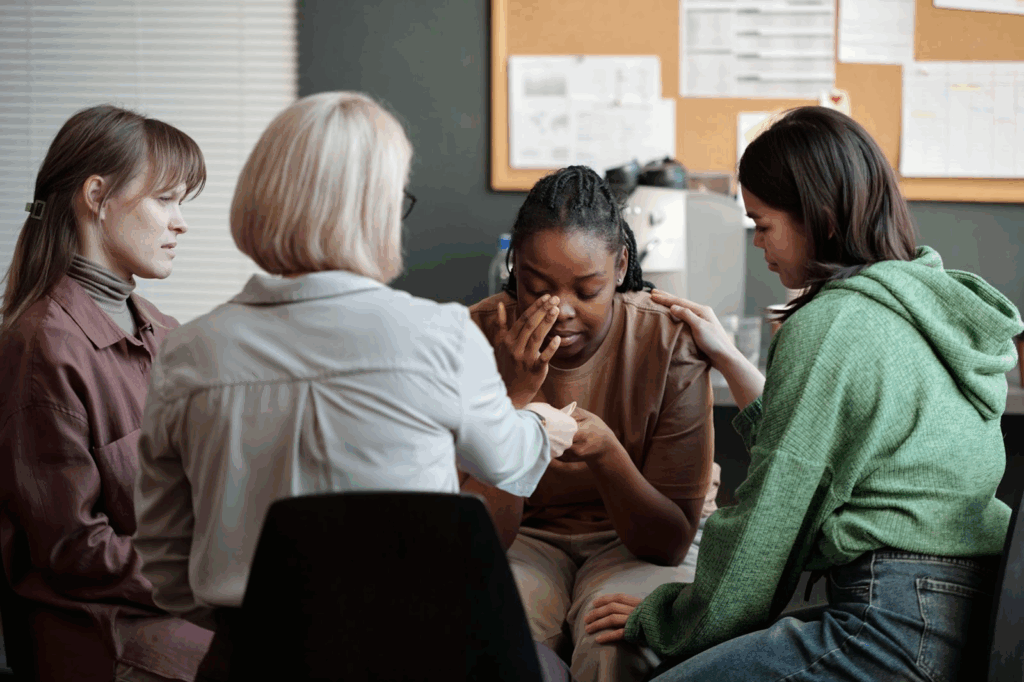
Anxiety in teens rarely looks like a single symptom; it’s a weave of restlessness, irritability, perfectionism, stomachaches, sleep changes, and sudden avoidance of once-loved activities. In adolescent therapy, the aim isn’t to erase nerves but to teach a nervous system how to downshift. Clinicians help teens spot triggers, map bodily cues, and practice simple regulation tools—paced breathing, grounding through the senses, and thought-challenging that replaces catastrophe with context. Just as important, therapy widens the teen’s world again: exposure steps are planned, small, and compassionate, so the cafeteria, the classroom, and the team bench feel possible instead of perilous. Parents learn to coach rather than rescue, reinforcing progress without amplifying fear.
Mood Regulation and Irritability in Adolescent Therapy
Rapid mood shifts can mask depression, especially when sadness shows up as anger or withdrawal. In adolescent therapy, teens learn to track the chain from sensation to emotion to choice, replacing snap reactions with purposeful pauses. Clinicians normalize the role of sleep, movement, and nutrition, then layer in cognitive and behavioral skills that help teens transform loops of negative self-talk into more accurate appraisals. Family involvement matters; parents practice responding to distress without escalating it, and they learn to distinguish “won’t” from “can’t” when motivation drops.
Watch For Functional Changes
A shrinking social life, slipping grades, or losing interest in hobbies often signal more than a “bad mood.”
Build Reliable Micro-Habits
Short walks, light exposure in the morning, and consistent bedtimes stabilize mood faster than teens expect.
Peer Pressure in Adolescent Therapy
Pressure to fit in doesn’t end with the school bell; it persists in group chats at midnight and weekend meetups, where “everyone else” is supposedly bolder. In adolescent therapy, teens rehearse scripts for real-life moments: how to decline without drama, how to exit a risky scene, and how to name personal values without sounding like a lecture. Sessions also unpack the social math behind choices—what a short-term “yes” costs in long-term trust, how reputations travel, and why the best friends are the ones who respect a boundary and still stick around. Parents learn to replace lectures with curiosity, turning “Don’t do it” into “What would make that easier to refuse?”
Make The First Refusal Line Short
A simple “I’m out; I’ve got training tomorrow” is easier to deliver than a long explanation.
Preplan Exits
A ride code word or a shared location link reduces the friction of leaving a scene that feels wrong.
Adolescent Therapy for Academic Pressure, Perfectionism, and Procrastination
School stress often hides inside “high standards” until it curdles into dread. In adolescent therapy, perfectionism is reframed as a protective strategy that worked—until it didn’t. Teens learn to set both floor goals and ceiling goals, break assignments into time-bound sprints, and pair work blocks with pre-planned breaks so that motivation doesn’t rely on bursts of willpower. Counselors coordinate with schools when needed, aligning accommodations like extended time or reduced-load weeks after illness or crisis. Parents take on a coaching role, helping to structure study environments and praise effort, process, and recovery skills—not just outcomes.
Adolescent Therapy Changes in the Era of Social Media
Online life compresses popularity into numbers and carries conflict into bedrooms. In adolescent therapy, teens learn media literacy: how algorithms tilt attention, how curated images warp norms, and how to use settings that slow the scroll. Safety planning includes documenting harassment, blocking quickly, and escalating to adults early. Sessions also restore context: teens practice noticing what their body feels like during doomscrolling and what changes when they swap screens for movement, music, or in-person connection. The goal isn’t zero screen time; it’s intentional use that protects mood and social standing.
Create Device Fences
Charging phones outside the bedroom and setting quiet hours improve sleep and reduce late-night spirals.
Rebuild Offline Identity
Clubs, sports, jobs, and creative projects dilute the power of online feedback loops.
How Adolescent Therapy Builds Identity, Belonging, and Self-Confidence
Adolescence is an ongoing identity draft, especially around culture, values, sexuality, and gender expression. In adolescent therapy, teens get a confidential space to explore questions without pressure to finalize answers. Clinicians validate the uneven pace of identity formation and help teens practice language that fits their current understanding, including how to talk with caregivers and friends. Families learn supportive responses—listening first, asking open questions, and agreeing on privacy boundaries—so home becomes a safer place to grow. Confidence rises not from slogans but from repeated experiences of being taken seriously and treated with respect.

Family Conflict and Communication in Adolescent Therapy
Many home arguments are repeats of the last argument in new costumes. In adolescent therapy, families slow the cycle down and change the choreography: one person speaks, another reflects, and everyone agrees on “time-in” signals before the room gets loud. Teens practice owning impact (“I slammed the door; I was overwhelmed”) while parents shift from cross-examining to collaborative problem-solving. Boundaries are clarified—around curfews, cars, screens, and school—so fewer decisions happen in the heat of conflict. Repair becomes routine: short apologies, concrete do-overs, and check-ins that prevent resentments from calcifying.
Separate Behavior From Character
Naming actions, not identities, keeps dignity intact and makes change more likely.
Use Brief Agenda Meetings
A 10-minute weekly family check-in reduces the need for hallway debates.
Navigating Substance Experimentation in Adolescent Therapy: Explaining the Risks
Curiosity about substances intersects with sensation-seeking and social status. In adolescent therapy, education is frank and non-shaming: teens learn how substances affect a developing brain, how tolerance and withdrawal work, and how impairment distorts consent and safety. Counselors teach refusal and exit skills while also watching for underlying drivers—anxiety, trauma, or social exclusion—that make intoxication feel like relief. Families collaborate on clear, enforceable expectations and practical safeguards, such as transportation plans and honest call-me-anytime agreements. When patterns suggest a substance use disorder, therapists coordinate with specialized programs to match the intensity of care to the level of risk.
Preventing Self-Harm and Suicidal Thoughts with Adolescent Therapy
Some teens cope with intense feelings through self-harm or report thoughts of not wanting to be alive. In adolescent therapy, safety is the first priority and is addressed with compassion and structure. Clinicians assess risk, create written safety plans, and involve caregivers appropriately while honoring as much teen privacy as safety allows. Teens learn alternative coping strategies for overwhelming emotion and practice asking for help sooner, not later. Families receive guidance on reducing access to lethal means, increasing supervision during spikes in risk, and responding to disclosure with calm, validating language rather than panic.
Take All Disclosures Seriously
A caring, steady response opens the door to ongoing support and timely professional help.
Keep The Plan Visible
Crisis numbers, trusted adults, and coping steps should be easy to find when distress surges.
Adolescent Therapy in Times of Trauma, Grief, and Big Transitions
Loss—of a person, a friendship, a home, or a sense of safety—rearranges a teen’s inner world. In adolescent therapy, trauma-informed approaches help teens process memories without re-injury and build routines that restore a sense of control. Grief has no tidy timeline; therapy normalizes the coexistence of good days and hard days. Schools may adjust workload temporarily, and families can anchor the teen with predictable sleep, meals, and connection. When transitions arrive—a move, a breakup, a family blend—therapy helps teens carry forward what matters and set boundaries that protect emerging identities.
Executive Skills, Motivation, and Daily Habits in Adolescent Therapy
Between big emotions and big expectations, daily life skills often lag: planning, prioritizing, starting and finishing tasks. In adolescent therapy, executive functioning gets practical attention. Teens test tools—visual schedules, two-minute start rules, body-doubling for homework—and analyze which conditions actually help them show up. Motivation is treated like a system, not a moral trait. With small wins stacked and celebrated, teens experience self-efficacy, the engine that pulls grades, chores, and commitments in a healthier direction. Parents learn to swap nagging for scaffolding and to fade support as skills solidify.

How Schools Incorporate Adolescent Therapy to Improve Student Wellness
Many goals cross settings, so coordination matters. In adolescent therapy, and with consent, counselors communicate with school teams about accommodations, behavior plans, and re-entry after crisis or hospitalization. Pediatric and psychiatric providers align on medication questions and sleep or nutrition guidance. The teen stays centered: they learn to advocate for themselves, track what helps, and speak up when a plan stops working. Progress becomes visible through fewer absences, smoother mornings, and relationships with teachers that feel less adversarial and more allied.
Keep Data Simple And Useful
Short weekly checklists from home and school show what’s improving and what needs attention.
Review And Iterate
Plans should evolve as classes, seasons, and stressors change.
Finding the Right Adolescent Therapy Fit
Therapy works best when it feels safe and purposeful. Start by clarifying goals—fewer panic spikes, better sleep, safer choices with friends—and by choosing a clinician with relevant experience. In the first meetings, notice whether your teen feels respected and whether the therapist balances empathy with skill-building. Ask about privacy limits and how caregivers will be involved. Effective adolescent therapy blends individual sessions with parent guidance, and it sets measurable checkpoints so everyone can see momentum. The process isn’t about perfection; it’s about steady movement toward a life that fits the teen’s values and capacities. When a good fit is in place, change often arrives sooner than expected—and with staying power.
Visit the Moving Forward PLC blog to learn more about adolescent therapy and how it can provide your teens with confidence and a place to feel seen.
